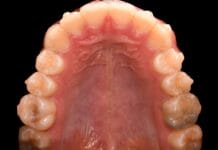Are you in need of CE credits? If so, check out our peer-reviewed, self-study CE courses here.
Test Your Oral Manifestations of Bacterial Infections Knowledge
1. Oral manifestations of syphilis are often the first signs of disease.
Syphilis is an infection caused by the spirochete bacterium Treponema pallidum. It is primarily spread through sexual contact but can also be transmitted from an infected mother to her baby during pregnancy, leading to congenital syphilis. The incubation period typically ranges from 20 to 40 days. Humans are the sole host for T. pallidum, with no known animal reservoir.
Oral manifestations are often the first signs of syphilis. The characteristic lesion of primary syphilis, known as a chancre, typically appears at the site of infection about two weeks after exposure. Common locations include the buccal mucosa, tongue, and lips.
A chancre generally presents as a solitary, painless, firm, round nodule with indurated edges, often accompanied by regional lymphadenopathy. It begins as a macule that develops into a papule, which may erode into an ulcer ranging from 0.5 to 1.5 cm in diameter. In some cases, petechial hemorrhages may be visible on the soft palate, with or without the presence of a chancre.
The painless nature of the syphilitic lesion is a key feature that helps distinguish it from squamous cell carcinoma.
Saini, M. (2023, March 19). Bacterial Infections of the Oral Mucosa. StatPearls. https://www.statpearls.com/articlelibrary/viewarticle/131802
2. Which of the following is a common oral manifestation of congenital syphilis?
Congenital syphilis can be transferred from an infected mother to the fetus after 16 weeks of pregnancy. Prior to 16 weeks, the fetus is protected from transmission through the mother's immune system, specifically by Langerhans cells. At around 16 weeks of pregnancy, the presence of Langerhans cells decreases, which allows the bacterium to pass from mother to fetus.
Babies born with syphilis experience various developmental defects, some of which manifest orally. Common dental anomalies include Hutchinson's incisors, mulberry molars, and enamel hypoplasia.
Hutchinson's incisors appear small, widely spaced, peg-shaped, and semitranslucent with a screwdriver-shaped incisal edge. Mulberry molars, also referred to as Moon molars, appear with small, dome-shaped cusps set closer together than typical molar anatomy. Mulberry molars may also have enamel hypoplasia.
Saini, M. (2023, March 19). Bacterial Infections of the Oral Mucosa. StatPearls. https://www.statpearls.com/articlelibrary/viewarticle/131802
3. Oropharyngeal gonorrhea is common because saliva is a hospitable environment for N. gonorrhoeae.
Gonorrhea is caused by the gram-negative bacterium Neisseria gonorrhoeae. This bacterium primarily targets mucous membranes, leading to urethritis in men and cervicitis in women.
Oropharyngeal gonorrhea is relatively rare due to the inhospitable nature of saliva for N. gonorrhoeae. However, the infection can still be transmitted through oral sex or kissing, even if the infected person shows no symptoms.
Oral gonorrhea is symptomless in many cases. However, a persistent sore throat is the most predominant feature when symptomatic. Other possible signs may include acute ulceration, diffuse oropharyngeal erythema, and edematous tissues that bleed easily.
Saini, M. (2023, March 19). Bacterial Infections of the Oral Mucosa. StatPearls. https://www.statpearls.com/articlelibrary/viewarticle/131802
4. What is the most common location for oral lesions related to primary tuberculosis infection?
Tuberculosis (TB) is a granulomatous disease caused by the aerobic acid-fast bacillus Mycobacterium tuberculosis, typically leading to a primary infection in the lungs. M. tuberculosis is transmitted via aerosols released during coughing, sneezing, or talking. These bacteria can linger in the air for extended periods, posing a risk of infection to others.1
Although the likelihood of TB transmission in a dental setting is low, it remains a concern, particularly with patients from regions with high TB prevalence or those with reactivated infections.1
Oral TB lesions are rare, with most cases arising as a secondary infection, often spreading through the bloodstream. Lesions are commonly located on the tongue, buccal mucosa, gingiva, lips, and the floor of the mouth.1,2
Primary (initial infection) oral TB typically affects the gingiva of children and young adults, presenting as a solitary, painful, necrotic ulcer.1,2 Ulcers may extend from the sulcular epithelium and other areas of the oral cavity to the base of the adjacent vestibule. These ulcers can persist for more than two to three weeks. Primary lesions are often linked to the disease spreading to the cervical lymph nodes, which become enlarged and tender. Additionally, tuberculosis osteomyelitis may manifest as lesions within the jaw.1
In contrast, secondary (reactivation or chronic infection) oral TB lesions are more prevalent among middle-aged and older adults and mainly affect the tongue.2 Lesions present as slow-growing, painful ulcers that do not resolve with irregular borders and a thick white mucus at the base of the lesion.1
- Saini, M. (2023, March 19). Bacterial Infections of the Oral Mucosa. StatPearls. https://www.statpearls.com/articlelibrary/viewarticle/131802
- Sriram, S., Hasan, S., Saeed, S. et al. Primary Tuberculosis of Buccal and Labial Mucosa: Literature and a Rare Case Report of a Public Health Menace. Case Reports in Dentistry. 2023; 2023: 6543595. https://onlinelibrary.wiley.com/doi/10.1155/2023/6543595
5. Scarlet fever is caused by Streptococcus pyogenes. The most common oral manifestation is strawberry tongue.
Scarlet fever is caused by Streptococcus pyogenes, a bacterium that belongs to the group A beta-hemolytic streptococci (GABHS). It can develop in those who have strep throat and occasionally from streptococcal skin or wound infections. It is most prevalent in children from five to 15 years old but can develop in all age groups. Humans are the primary reservoir for this bacterium, with an incubation period of about two to five days.
One of the hallmark oral signs of scarlet fever is a strawberry tongue, characterized by hyperplastic fungiform papillae and a white coating on the tongue. The tongue appears red and bumpy as the white coating resolves because of the remaining papules. The throat may also appear red and inflamed, often with white or yellow patches, making swallowing painful.
Saini, M. (2023, March 19). Bacterial Infections of the Oral Mucosa. StatPearls. https://www.statpearls.com/articlelibrary/viewarticle/131802












